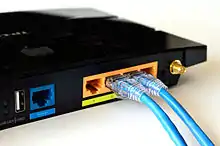Residential gateway
A residential gateway is a small consumer-grade router which provides network access between local area network (LAN) hosts to a wide area network (WAN) (like the Internet) via a modem. The modem may or may not be integrated into the hardware of the residential gateway. The WAN is a larger computer network, generally operated by an Internet service provider.
Devices

Multiple devices have been described as "residential gateways":
- Cable modem
- DSL modem
- Wireless router[1]
- Network switch
- Voice over internet protocol (VoIP) analog telephone adapter
- Wireless access point
- Wired router
- IP-DECT telephone (base station)
or certain combinations of the above.
A modem (e.g. DSL modem, Cable modem) by itself provides none of the functions of a router. It merely allows ATM or Ethernet or PPP traffic to be transmitted across telephone lines, cable wires, optical fibers, or wireless radio frequencies. On the receiving end is another modem that re-converts the transmission format back into digital data packets.
This allows network bridging using telephone, cable, optical, and radio connection methods. The modem also provides handshake protocols, so that the devices on each end of the connection are able to recognize each other. However, a modem generally provides few other network functions.
- A USB modem plugs into a single PC and allows a connection of that single PC to a WAN. If properly configured, the PC can also function as the router for a home LAN.
- An internal modem can be installed on a single PC (e.g. on a PCI card), also allowing that single PC to connect to a WAN. Again, the PC can be configured to function as a router for a home LAN.
A wireless access point can function in a similar fashion to a modem. It can allow a direct connection from a home LAN to a WAN, if a wireless router or access point is present on the WAN as well.
However, many modems now incorporate the features mentioned below and thus are appropriately described as residential gateways.
Features
A residential gateway usually provides
- configuration via a web interface,[2]
- routing between the home network and the Internet,
- connectivity within the home network like a network switch,
- network address translation (NAT) for IPv4,[3]
- DHCP for IPv4 and increasingly router advertisements for IPv6,
- firewall functions, and
- wired or wireless telephony.
It may also provide other functions such as Dynamic DNS.[4]
Most routers are self-contained components, using internally stored firmware. They are generally OS-independent, i.e., they can be accessed with any operating system.
Wireless routers perform the same functions as a router, but also allow connectivity for wireless devices with the LAN, or between the wireless router and another wireless router. (The wireless router-wireless router connection can be within the LAN or can be between the LAN and a WAN.)
Security
Low-cost production and requirement for user friendliness makes the home routers vulnerable to network attacks, which in the past resulted in large clusters of such devices being taken over and used to launch DDoS attacks.[5] A majority of the vulnerabilities were present in the web administration consoles of the routers, allowing unauthorised control either via default passwords, vendor backdoors, or web vulnerabilities.[6]
See also
- Customer-premises equipment
- Home network
- Home server
- Multimedia over Coax Alliance
- LAN switching
- Technological convergence
- List of wireless router firmware projects
References
- Wireless router is a combination of wired router and wireless access point.
- Martin, Jim. "Can't access 192.168.1.1: how to change router settings including Wi-Fi password". PC Advisor. Retrieved December 21, 2015.
- "NAT Router Security Solutions". Gibson Research Center. Retrieved December 22, 2015.
- Ou, George. "Make your home PCs accessible anywhere with Dynamic DNS for free". Techrepublic. Retrieved December 21, 2015.
- Gayer, Ofer. "Lax Security Opens the Door for Mass Scale Abuse of SOHO Routers | Incapsula.com". www.incapsula.com. Retrieved 2015-06-16.
- Niemietz, Marcus; Schwenk, Joerg (2015). "Owning Your Home Network: Router Security Revisited". arXiv:1506.04112 [cs.CR].
External links
- The Residential Gateway (a vision paper published in International Engineering Consortium’s 1996 Annual Review of Communications, p.457)
- Home Gateway Initiative, a group of broadband providers proposing specifications for residential gateways
- The Residential Home Gateway on About.com